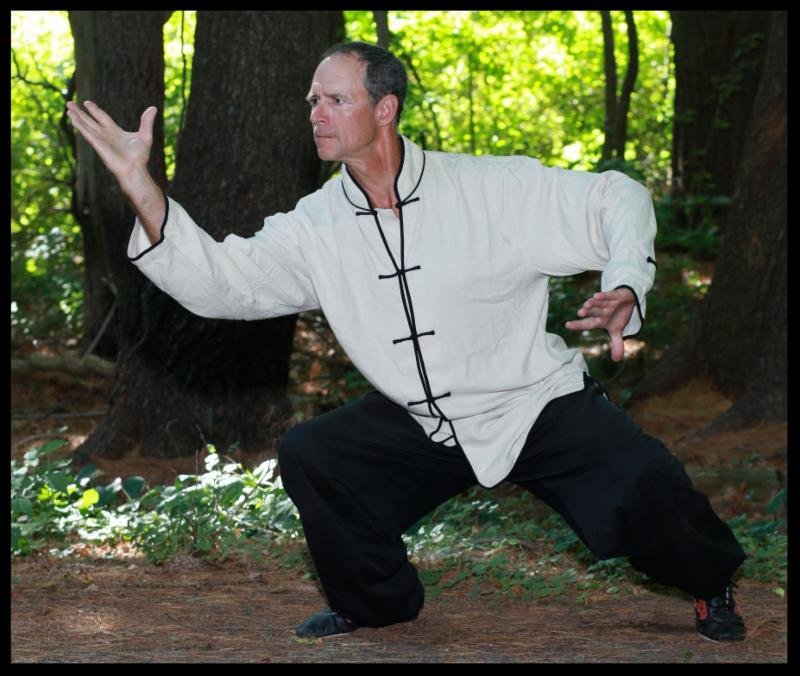Tai Chi and Hanna Somatic Education as Complementary Disciplines
John Loupos. M.S., C.H.S.E.
Readers note: John Loupos recently had the privilege of being invited as a virtual presenter at the 2021 International Medical Tai Chi and Qigong Association Conference. His presentation transcript has been copied below.
Tai Chi, for all its inherent merits, can be much enhanced by certain auxiliary practices, the most obvious and prevalent of which are various forms of qigong. One non-traditional practice that I’m well versed in is Hanna Somatic Education, which I’ll be referring to here as Hanna Somatics, or just Somatics. Tai Chi Chuan and Hanna Somatics stem from very different times and cultures. Yet they share many features in common. Tai Chi Chuan and Hanna Somatics both emphasize mindful movement – meaning movement that is slow, deliberate, and purposeful. Both place a high value on self-sensing, on ergonomically correct posture and carriage, on movement that is optimally efficient, and on a healthy mental state that is conducive to self-actualization and personal freedom.
Several of these features qualify under the rubric of interoception. Conscious interoception describes a profound state of first-person attention to, and awareness of, one’s own body. Deliberate interoception is generally implicit during Tai Chi study and can, therefore, prove elusive for students newer to the discipline. Evidence of more highly evolved interoception is typically seen only at an advanced Tai Chi skill level. However, interoception (and notably, guidance in how to interocept) are explicit and primary features of Hanna Somatics, and are among the first things a student or client new to Hanna Somatics learns. In my experience students at Tai Chi, and including qigong, all too often arrive with bodies that are already encumbered by the effects of injuries, stress, or other debilitation. This is predictably true with enrollees who are at or above early middle age when physical decline is most likely to announce itself. When it does it is usually mis-attributed as being aged-related. Similar states of decline are described in the Somatics lexicon as being due to what we call the myth of aging. While it is a de facto truth that bodies decline as people get older – hence the myth – much of the functional decline that people experience is not due to aging, per se, but rather to the cumulative effects of what I’ve coined as the archeology of insults. That is, for many people the great bulk of decline in neuromuscular function-and-control is a learned response to the various physical and mental insults that people inevitably encounter as they move through their lives.
A limiting effect of such insults is to incrementally compromise the communication between brain and body that normally occurs via the sensorimotor pathways, so that muscular performance becomes progressively less differentiated as the affected muscles adopt a new default state of hypertonus. The resulting pain or stiffness in the muscles may appear as a local problem, but once sensorimotor compromise, referred to in Somatics as sensorimotor (or more correctly motor-sensory) amnesia, has become imprinted as a maladaptive default pattern in the neural circuitry local redress becomes less effective as a durable solution. Because it’s alway a seller’s market when it comes to neural real estate, oversight of muscles that are compromised by sensorimotor amnesia gets shunted off to the subcortical regions of the brain that are responsible for managing our automatic movement programs. Hanna Somatics is specifically designed to undo the effects of this decline by recorticalizing sensory awareness and control of voluntary muscles for greater freedom overall. The seeming complexities of neuro-speak aside, I’ve found that the effects of sensorimotor amnesia are fairly easy to address in most cases using the Somatics methodology. It may be brain science, but it’s not rocket science.
*** I will also note here that for all the common ground that Tai Chi Chuan and Hanna Somatics share, the two disciplines also differ in four significant regards.
First, Tai Chi offers a martial component that Hanna Somatics lacks, though it is worth noting that the Tin Jing listening skill requisite to Tai Chi pushing hands does require an evolved element of interoceptive awareness.
Second, Tai Chi is typically practiced in a standing (or vertical) format, whereas Somatics is usually practiced according to some horizontal variation, either prone, supine, or sideline, which allows the system, or soma, to experience itself outside the usual and reinforcing constraints of gravity on an upright body.
Third, Tai Chi pays explicit attention to the experience and cultivation of qi energy. While deliberate attention to qi is notably absent from the Hanna Somatic tradition, I believe this to be a cultural omission only. In my experience Hanna Somatics is very “qi friendly.” Consider that just as water cannot flow easily though a hose that has become kinked, neither can qi flow easily through a body that is encumbered by tight muscles and their ensuing hyper-stabilized joints. Because Hanna Somatics is so exceptionally effective at restoring a healthy default tonus to hypertonic muscles it fosters an internal milieu that is highly conducive to the flow of qi energy.
Finally, Tai Chi sees value in differentiated movement as a means to another end, that end being the improvement of one’s skill level at Tai Chi, again often for martial purposes. Hanna Somatics values differentiated movement for its first person benefits, most immediately as a reprieve from pain and stiffness, and also as a means to improved neuromuscular intelligence, and therefore as a goal onto itself.
In conclusion, I see Tai Chi and qigong as being highly compatible with Hanna Somatics. Tai Chi offers the potential to reinforce in a vertical posture information and skills that have been acquired during Somatics floor or table work. At the same time I see Somatics as being of inestimable value to those who practice at Tai Chi, as it can quickly and effectively address physical encumbrances that would preclude Tai Chi’s requisite body control, as well as fostering interoceptive awareness and a smarter and more compliant body in the process.
Thank you.
*****************************************************************************************************************************
I will now guide those of you who would like to follow along in a simple abbreviated movement pattern that you can practice while lying on your back or, if you prefer, from the comfort of the chair you’re sitting on.
I’m sure that those of you who are teachers of Tai Chi or Qigong can relate when I say that tightness in the shoulders and upper back area serves for many people as a pesky impediment to movement that presents as fluid and well controlled. Let’s see what we can do now with you over the next few minutes to improve on your shoulders. Actually, I’m going to guide you in working with one shoulder only so as to highlight for comparison whatever changes you feel on one side as a result of practicing this brief movement pattern. I’ll use language that focuses on your right shoulder, but you can choose whichever shoulder you prefer to focus on and adjust your movements accordingly.
Start by assuming a comfortable posture, whether sitting or lying flat on your back. You won’t need to watch me on your screen as I’ll provide clear spoken directions to guide you along. Close your eyes and begin to turn your attention more deliberately inward. Before we begin in earnest notice how your shoulders each feel and how they compare one to the other. How flat are they against the floor? Do they feel equally weighted? Do they move in a same fashion, or at all, with the natural ebb and flow of your breath.
Whether you’re sitting or lying flat, raise your right arm up overhead toward the ceiling. Begin to rotate your hand around to the right, as if turning off a tap or spigot. Due sure to turn slowly so you can fully appreciate the process of rotation and where it comes from in your muscles, your tendons, and your bones. Pause briefly once you reach your comfortable limit… and then reverse back, turning slowly to the opposite direction. Continue back and forth like this on your own several times, making note of both your overall range of motion and of the relative ease with which you can execute this back and forth action.
As you continue, notice that as your hand rotates so does your elbow. Even though you haven’t had any explicit intention to move your elbow it is turning. Shift your primary intention now to the elbow as you rotate it inward… and then slowly outward. Notice that your hand continues to rotate even as your focus has shifted to the elbow. No third party observer would discern these awarenesses, but you can feel them quite clearly. This is the beginning of interoception. Notice as your elbow rotates that there is also an involvement at your shoulder, and extending back to the shoulder blade, or scapula. Begin to shift your primary attention and intention from your elbow to your shoulder blade and feel its sliding/gliding movement. The scapula is designed as a sliding joint and as such it should be able to glide freely across the rib cage. As your hand and elbow turn downward and then outward your scapula will slide higher, gliding up toward the back of your head. Then, as your hand and elbow rotate downward and inward you’ll feel your scapula sliding lower and snugging in toward the centerline. Where your shoulder blade played only a minor role just a few rotations ago you can now feel the fullness of its movement as the primary impetus for turning your arm, elbow, and hand.
You may have noticed that your hand, your elbow, and your scapula all tend naturally to rotate in sync…. Let’s have you pause for a moment and see if you can rotate only your hand. As the hand first rotates inward allow it to pull the elbow along in tow. As the elbow moves inward let it invite the shoulder blade to begin snugging down. Then reverse, unraveling just your hand, then your elbow, then your scapula. Let’s try this in reverse order. Start by snugging down just your scapula. Let the elbow follow the scapula inward. Complete the move by turning your hand to follow the elbow.
Now rest your arm down and close your eyes. Notice inward for any sensations stemming from these differentiations. If you’re lying down you will certainly feel your working side arm and shoulder as noticeably flatter against the floor. Your working arm will likely feel more alive, and more enlivened, this pretty much as I expect you’d be wanting it to feel during a good round of Tai Chi practice. You can open you eyes now and finish by moving both of your arms and shoulders about as if you are practicing at Tai Chi. Which arm says, “I’m finally feeling really soft and relaxed, yet surprisingly smart and sensorially aware?”
We have in these simple moves a reasonable sample of what it’s like to free the body, or its parts, using Somatics movement patterns. Table work in a clinical setting under the guidance of trained Hanna Somatic Educator is even more expedient. Thank you. I hope you found value in this presentation. I’ll now do my best to answer any questions that anyone has. Questions & Answers.

